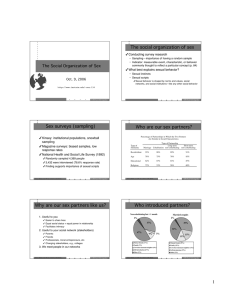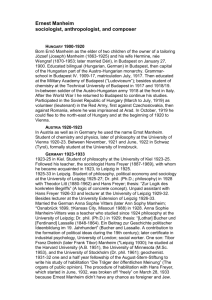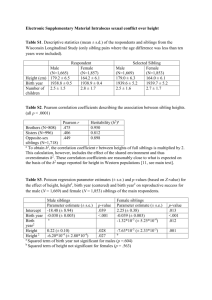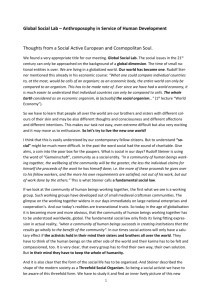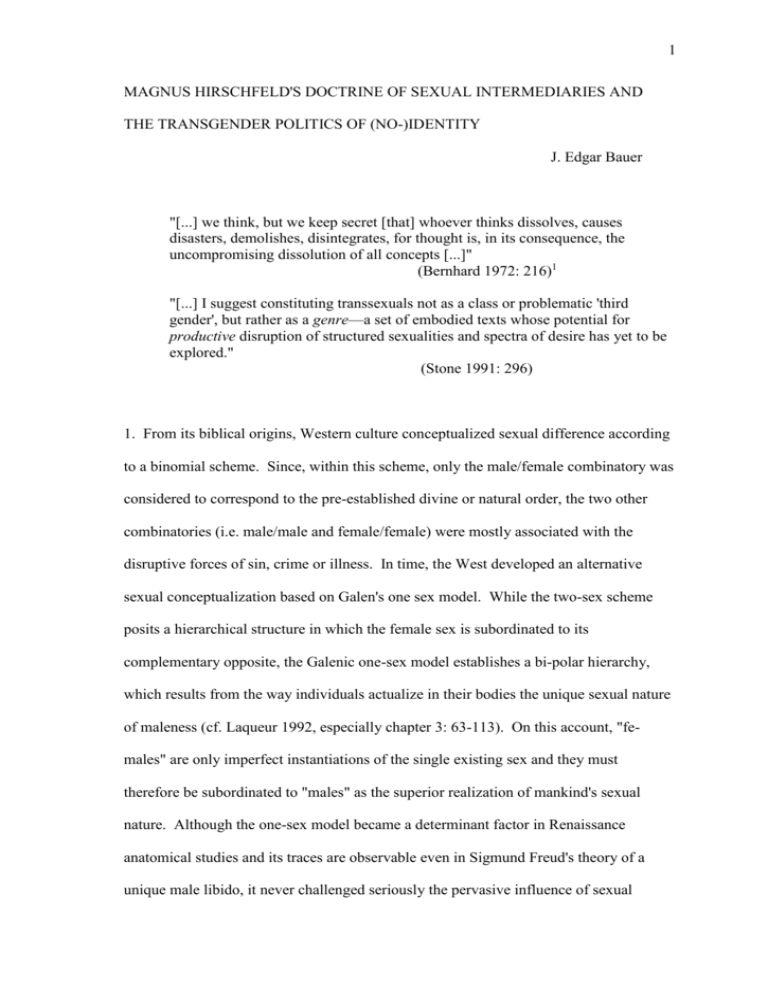
1
MAGNUS HIRSCHFELD'S DOCTRINE OF SEXUAL INTERMEDIARIES AND
THE TRANSGENDER POLITICS OF (NO-)IDENTITY
J. Edgar Bauer
"[...] we think, but we keep secret [that] whoever thinks dissolves, causes
disasters, demolishes, disintegrates, for thought is, in its consequence, the
uncompromising dissolution of all concepts [...]"
(Bernhard 1972: 216)1
"[...] I suggest constituting transsexuals not as a class or problematic 'third
gender', but rather as a genre—a set of embodied texts whose potential for
productive disruption of structured sexualities and spectra of desire has yet to be
explored."
(Stone 1991: 296)
1. From its biblical origins, Western culture conceptualized sexual difference according
to a binomial scheme. Since, within this scheme, only the male/female combinatory was
considered to correspond to the pre-established divine or natural order, the two other
combinatories (i.e. male/male and female/female) were mostly associated with the
disruptive forces of sin, crime or illness. In time, the West developed an alternative
sexual conceptualization based on Galen's one sex model. While the two-sex scheme
posits a hierarchical structure in which the female sex is subordinated to its
complementary opposite, the Galenic one-sex model establishes a bi-polar hierarchy,
which results from the way individuals actualize in their bodies the unique sexual nature
of maleness (cf. Laqueur 1992, especially chapter 3: 63-113). On this account, "females" are only imperfect instantiations of the single existing sex and they must
therefore be subordinated to "males" as the superior realization of mankind's sexual
nature. Although the one-sex model became a determinant factor in Renaissance
anatomical studies and its traces are observable even in Sigmund Freud's theory of a
unique male libido, it never challenged seriously the pervasive influence of sexual
2
binarism, whose ideological prestige was supported by biblical revelation and allegedly
observable factuality. Not surprisingly, as the representatives of the early homosexual
emancipation movement in Germany began to articulate their theoretical coordinates in
the late 19th century, their conceptualization of sexual difference assumed the existence
of two distinct sexes in nature. Their contention regarding the "third sex" was meant,
first and foremost, as an "addition" or "supplement" to the traditional binomial scheme
of sexual distribution.
2. Against the double backdrop of a first, paternal, ruling sex, and a second, maternal,
subordinate sex, the third sex was supposed to surpass their mutual exclusion and
reconcile them in one and the same individual. For its modern advocates, the third
sexual mode was an indispensable accretion to binary sexuality designed to closure the
possibilities of what is conceivable as "sex". Later on, the third sex was conceived as an
emblematic sexual variety that, besides superseding binomial sexuality, initiates a sexual
series, which excludes the idea of its own final completion. Both the "suppletive" and
the "serial" conceptions of the third sex acknowledged the intrinsic precariousness and
instability of the male/female disjunction. While the proposal of a "suppletive" third sex
sought to overcome the limitations of the sexual binomium by adding a collective
category that included all previously rejected or ignored sexual alternatives, the
postulation of a "serial" third sex reflected the insight that no final sexual category can
do justice to the inexhaustible variability of human sexuality.
3. From a semantic perspective, the third sex concept intended something more
encompassing and fundamental than the mere enlargement of the sexual combinatory as
implied by the nineteenth century coinage of the term "homosexuality". While the
homosexual combinatory can be subsumed, in principle, under the male/female scheme
3
of sexuality without questioning the validity of sexual binarism, the third sex constitutes
a destabilizing factor of the disjunctive alternative itself. In the last resort, the same-sex
alternative presupposes the binomial distribution in men and women in order to warrant
the postulation of male/male and female/female sexual configurations. Distinct from the
corroborative strategy implicit in the homosexual category, third sex—in its suppletive
and serial meanings—call to question the cogency of binomial sexuality from the liminal
perspective of the excluded. While the suppletive model adds a third alternative without
necessarily transforming the binomial self-understanding of the alleged majority, the
open-ended model challenges from the outset the very existence of such a majority by
questioning the theoretical validity of its cohesion.
4. Without doubt, the most eminent representative of the suppletive understanding of the
third sex in the nineteenth century was Karl Heinrich Ulrichs (1825-1895). In a letter to
his sister dated September 22, 1862, he redefined sexuality within a triadic scheme of
sexual modes and concluded: "We constitute a third sex." (Ulrichs [1899] 1994: 47)2
Basically, Ulrichs viewed male Uranians as female souls trapped in male bodies.3
Further, he regarded them as well as their female counterparts as appertaining to a
separate, third sexual class clearly distinguishable from normal men and women (cf.
Ulrichs [1864]: 5)4. From its inception, however, Ulrichs' third sex category was marked
by a specific instability. In the letter quoted, Ulrichs asserted that "sexual dualism" is
present embryonically in every human individual, but that it manifests itself in a greater
degree in hermaphrodites and Uranians than in normal men and women.(Cf. Ulrichs
[1899]: 68)5 Despite his intuitive awareness that all humans are to a greater or lesser
extent bisexual, Ulrichs obviously decided to disregard his insight for reasons of
argumentative strategy, and declared programmatically: "We are not concerned by any
intermediary degrees." (Ulrichs [1899]: 46)6 Thus, Ulrichs' construction of a separate
4
third sex was determined by his conscious neglect of other sexual intermediary degrees
capable of revealing the subjacent natural continuum of sexual variability.
5. Within the sexual emancipation movement, Ulrichs was not the only theoretician to
neglect his own insights regarding the sexual natural continuum. Philosophical writer
and poet John Henry Mackay (1864-1933), who had a considerable influence on the
pederastic-oriented group of "Die Gemeinschaft der Eigenen" ("The Community of the
Self-Owners"), contended that "[i]n nature there [are] only transitions […] of the most
diverse kinds" (Mackay 1979: 263)7 and even went on to assert that gradual stages
(Stufen) lead from one sex to another (cf. Mackay 1979: 263). Consequently, Mackay
emphasized the "enormous variety of love" (Mackay 1979: 223)8 and "how infinitely
diverse [are] not just only the love inclinations of human beings" (Mackay 1982: 186)9.
As a libertarian anarchist, Mackay viewed future salvation as dependant on the liberation
of the individual (cf. Mackay 1979: 77)10 and depicted the aim of history as a
"development of man toward difference" (Mackay 1979: 77)11. Despite his far-reaching
insights, however, he made no effort to present a consistent account of the inexhaustible
diversity of sexual forms. Similar to Ulrichs's fixation on the "third sex", Mackay rather
focused on the pederastic "nameless love", a sexual configuration essentially different
from the effeminate "third love" propagated, according tp Mackay, by Magnus
Hirschfeld and his circle. While avoiding to draw general implications from his insights
on sexual diversity, Mackay concentrated on the poetical apologetics of his amatory
preferences (cf. Bauer 2000).
6. Like Ulrichs and Mackay, Sigmund Freud was also aware of the pervasiveness in
nature of the intermediary sexual degrees. In the very first pages of "Three Essays on
the Theory of Sexuality" (1905), Freud unequivocally acknowledged that all sexual
5
intermediaries can be found in abundance, and even remarked that the "formation of a
series" (Reihenbildung) of these intermediaries "suggests itself so to speak
automatically." (Freud [1905]: 49)12 However, Freud was not prepared to assess the
possible systematic consequences of these facts for his general psychoanalytical theory.
Tellingly, Freud made it clear in "The Psychogenesis of a Case of Homosexuality in a
Woman" (1920) that psychoanalysis is not capable of explaining the essence of what is
called "male" and "female", and that it contents itself with adopting both concepts in the
conventional or biological sense as basis of its work (cf. Freud [1920]: 280)13. Freud's
uncritical adoption of binomial sexuality within the groundwork of psychoanalysis was a
momentous theoretical decision. For it led, among other things, to the unwarranted
acceptance of heterosexual teleology and to the psychoanalytical sanction of the
patriarchal distributions of sexuality and power.
7. Freud's neglect of the the serial formation of sexual intermediaries is all the more
significant as Austrian philosopher Otto Weininger (1880-1903) had stated, as early as
1903, the implications of assuming such intermediary stages. In the first part of his
classic study "Sex and Charakter. A fundamental investigation"14, Weininger asserts
that, in accordance with the universal principle of transition in nature, there are
innumerable degrees of "sexual intermediary forms" (sexuelle Zwischenformen) between
the male and the female (cf. Weininger 1980: 9)15. Since the completely male man and
the completely female woman are abstract ideals that as such do not exist in nature,
concrete human beings are, without exception, sexual intermediaries (cf. Weininger
1980: 10).16 According to Weininger, such a sexual condition should not be understood
as a mere "bisexual disposition", but as a "permanent double sexuality" (Weininger
1980: 10)17. However, despite his initial rejection of binomial sexuality, Weininger
contended in the second part of the book that, notwithstanding all sexual intermediary
6
forms, human beings are lastly men or women (cf. Weininger 1980: 98)18. The reason
for this rather surprising re-establishment of the previously deconstructed sexual
binomium does not depend on scientific arguments, but on the overall metaphysical
design of Geschlecht und Charakter itself. For the sake of a logic of overcoming, in
which spiritual "character" supersedes corporeal "sex", Weininger re-instates and
corroborates the "ideal" validity not only of the traditional dichotomy of man and
woman, but also the hierarchical organization of their ethical and societal relations.
Despite his metaphysical constrictions, Weininger, under the influence of Magnus
Hirschfeld's work, has the merit of being one of the first theoreticians to have
acknowledged and assessed the relevancy of conceptualising biological sexuality within
a serial framework.
8. To avoid calling into question the sexual binomium, Freud had to ignore Weininger's
innumerable sexual forms and misrepresent Magnus Hirschfeld's most fundamental
theoretical endeavours as conveyed in his "doctrine of sexual intermediaries"
(Zwischenstufenlehre). Conflating Ulrichs' and Hirschfeld's conception of the third sex,
Freud incorrectly attributed to Magnus Hirschfeld Ulrichs's thesis of a suppletive third
sex distinct from that of males and females and then proceeded to emphasize that
psychoanalytical research opposes categorically the attempt to consider homosexuals as
a separate group of people on account of their specific sexual disposition (cf. Freud
[1905]: 56)19. In "Leonardo da Vinci and a Memory of his Childhood" (1910) Freud
took against the acquiescence of homosexual men in being portrayed by "their
theoretical spokespersons" as "a separate sexual variety, sexual intermediaries, as a 'third
sex'" (Freud [1910]: 124)20. In 1916, he reiterated that male and female homosexuals are
depicted by their "scientific spokespersons" as a "special variety of the human species,
[as] a 'third sex'" (Freud 1916-1917: 301)21. Although Freud seems to refer to an
7
indefinite number of spokespersons, his target was first and foremost Magnus
Hirschfeld, at the time the most prominent spokesman of the homosexual rights
movement in Germany. By so doing, Freud revealed a fundamental misapprehension of
the actual tenets at stake in Hirschfeld's claims. Having neglected the fact that
Hirschfeld never pleaded for Ulrichs' suppletive understanding of a separate third sex,
Freud was incapable to acknowledge that Hirschfeld's use of the third sex concept marks
the theoretical inception of an open-ended series of sexual variability.
9. Although Magnus Hirschfeld made the concept third sex popular in the twentiethcentury, he did not use it very often in his own work. Despite favouring the term "third
sex" over "homosexuality" with its usual connotation of concomitant sexual acts (cf.
Hirschfeld 1991: 10 and 14), Hirschfeld underscored that he did not employ the term in
his scientific publications, where he preferred to use either "sexual intermediaries" or
"sexual transitions" (Hirschfeld 1919: 22-23)22. Significantly, the term appears
unqualified only in two titles of the more than 500 items Hirschfeld published in his
lifetime.23 In his popular writings, third sex designated a whole range of intermediate
forms of sexuality that could not be readily classified using the male/female scheme.
This heuristic advantage notwithstanding, Hirschfeld was well aware of the fact that
recurring to a third sexual alternative meant the addition of a further "fiction" to the
equally fictional categories of man and woman. Consequently, Hirschfeld never
regarded the third sex alternative as "something complete and closed in itself", but as an
indispensable "makeshift" (Notbehelf) designed to overcome the "extremely superficial
scheme of classification into man or woman" (Hirschfeld 1923: 23)24. More
importantly, the provisional postulation of the concept never led Hirschfeld to revoke his
fundamental insight that "all human beings are intersexual variants […]" (Hirschfeld
1986: 49)25.
8
10. One of the central assumptions of Hirschfeld's doctrine of sexual intermediaries is
that, strictly speaking, there are no men and women, but only human beings that are "to a
large extent male or to a large extent female." (Hirschfeld 1913: 4)26 As early as 1896,
Hirschfeld elaborated on essential traits of his encompassing Zwischenstudenlehre. In
Sappho und Sokrates (1896), his first sexological treatise, Hirschfeld does not only recur
to the theory of recapitulation of phylogenesis by ontogenesis, but also to the reality of a
bisexual primary disposition, whose traces or "remainders" can be readily perceived at
the physiological level: "Every man keeps his stunted womb, the uterus masculinus and
the superfluous nipples until death; likewise, every woman [keeps] her useless
epididymis and her spermatic cord" (Ramien 1896: 10)27. Arguing analogically,
Hirschfeld pointed out that, with regard to the psychic centre of sexual sensibility, "one
can definitely assume that, here also, residues of the drive subsist that on the whole are
eventually destined to disappear" (Ramien 1896: 11)28. Since "in their primary
disposition all human beings are with respect to their bodies and souls bisexual"
(Ramien 1896: 10-11),29 the inexhaustible diversity of sexualities results not from
qualitative, but from quantitative differences that are determined by the way the primary
sexual disposition reacts to processes that hinder or advance its development. Hirschfeld
underlines that the later a particular sexual difference is developed, the more significant
the influence the "residual" sex has on it (cf. Hirschfeld 1907: 22). Whereas gradual
deviations occur less frequently with regard to the primary sexual characteristics, and
more frequently with regard to the secondary ones, in the case of tertiary characteristics
such deviations occur even more frequently, as is shown by the high incidence of sexual
orientations at variance with the supposed norm. Against this backdrop, all artificially
separated sexual varieties prove to be transitions within the pervading continuity of
nature. Not surprisingly, Hirschfeld chose as motto for his treatise
9
Geschlechtsübergänge a quote from Leibniz' Nouveaux essais: "Tout va par degrées
dans la nature et rien par sauts" (Hirschfeld 1913: cover of the book and 1)30.
11. In light of Leibniz' principle, all artificially separated sexual varieties prove to be
only transitions within the pervasive continuity of nature. Instead of assuming a limited
number of sexualities, Hirschfeld's natural continuum of sexual gradation allows, in
principle, for infinite varieties of sexual constitutions depending on the way the poles of
the masculine and the feminine combine at the different levels of sexual description,
which include: (1) the sexual organs, (2) the so-called secondary sexual characteristics,
(3) the sexual drive, and (4) other psychological traits (cf. Hirschfeld 1984: 357 and
Hirschfeld 1926-1930: Volume I, 547-548). Since in this scheme sexual difference is
not determined in relation to one single excluded alternative (male or female), but in
relation to an open ended system of as yet only partially realised combinations of the
masculine and the feminine at the different descriptive layers, the sexuality of each and
every individual31 is characterized by a unique complexity. In the last resort, Hirschfeld
transforms the act of determining the sexuality of an individual into a task that precludes
final closure.
12. Hirschfeld´s sexological work develops two essentially different levels of
discursivity without trying to elucidate their problematic relationship. While, on one
level, the complex issues related to the concrete study of anormative sexualities clearly
dominate his writings, on another, meta-theoretical premises connected with the
potentially infinite diversity of sexualities are broached on several occasions, but never
properly developed. Given this disproportion, it is all the more important to keep in
mind the overall design of Hirschfeld's work in order to assess the true dimensions of his
critical achievements. In this connection, Hirschfeld's life motto per scientiam ad
10
justitiam offers a hermeneutical key that enables to understand his sexological program
as an encompassing deployment from lucid acknowledgment of the biological facts of
human sexuality to visions of a libertarian culture capable of coping with endless sexual
diversity. Hirschfeld's insights --at once natural and utopical-- give rise to an
emancipatory agenda that does not involve regression to or a revitalisation of an
idealised cultural past, like the one envisaged by the philhellenic, pederastic
Gemeinschaft der Eigenen. As an evolutionary monist with a keen sense of justice in
history, Hirschfeld does not conceive nature as something that can be realized in culture
once and for all, but as a dynamic process striving to create the conditions for an ever
more demanding freedom. By dismantling sexual dimorphism, its restricted
combinatories and also the "makeshift" of the third sex, Hirschfeld's texts not only open
up the possibility of a deeper understanding of the universal perplexities inherent in
being intersexually variant, but also sets the paradigms for realizing a sexually
libertarian culture.
13. Hirschfeld´s critical procedures seek to liberate the individual from the conceptual
fictions that hinder the full deployment of his or her sexuality. Since, by principle, this
sexuality cannot be adequately subsumed under a pre-established category, the doctrine
of sexual intermediaries sensu stricto dismisses the issue of sexual identity as
ideological, and transforms the question of sexual self-identification into an endless task,
in which categorisations can be, at most, provisory approximations that must be
constantly readjusted in order to fit the metamorphoses of multi-level sexual complexity.
Thus, the determination and expression of an individual's sexuality becomes a narrative
of changing sexual differences as determined against the background of latencies and
possibilities that underlie the sexual continuum of nature. Even though Hirschfeld did
not deal in detail with specific theoretical consequences, his interest in the sexological
11
aspect of biographies along with his tireless efforts to refine his theoretical
instrumentality make it apparent that he was ultimately guided by a concept of sexuality
that focused on diachronical differences. Such a conception calls for an understanding
of sexual alterity in which the alter, i.e. the heteron, is not determined within a binary
pattern, but is defined within the framework of potentially infinite sexual varieties, all
differing in gradually diversified aspects from one another. Sexuality in this new
understanding is without exception a sexuality of difference, and therefore always a
sexuality of the "other": "Hetero-sexuality".
14. Since the beginnings of the sexual emancipation movement and the emergence of
sexual science, the processes of sexual taxonomy (including sexual assignation and
sexual self-identification) were determined by an ever-growing complexity of
classificatory criteria. While in the 1860s Karl Heinrich Ulrichs took recourse to a twolevel scheme (consisting of body and soul) to explain the discordant composition of
"uranians" as a third sexual alternative, some decades later, Hirschfeld used a fourfold
scheme of sexual description (cf. § 11 above). In the present, as Judith Shapiro has
pointed out, biology and medicine differentiate alone at the bodily level between
chromosomal (or genetic) sex, anatomical (or morphological) sex, genital (or gonadal)
sex, germinal sex and hormonal sex (cf. Shapiro 1991: 250). Since Robert J. Stoller's
conceptual distinction between sex and gender (cf. Stoller 1968), the descriptive levels
referring to mental and behavioural aspects have been profusely diversified. Against the
background of these developments, the relevancy of Hirschfeld's meta-theoretical
scheme of sexual diversity consists in offering the instrumentality for dissolving the
traditional binomial scheme of sexuality without positing any closed sexual modes. On
his account, the "third sex" makeshift constitutes a conceptual bridge leading from
sexual binarism to the encompassing serial scheme of his own doctrine of sexual
12
intermediaries. While having a dissolvent effect on the fictions and fixations of sexual
dimorphism, Hirschfeld's concept of the third sex also functioned as a provisional
identificatory category for those deprived of their sexual rights in a society organized
according to traditional sexual patterns. Thus, in spite of its fictionality and
provisoriness, Hirschfeld's serial understanding of third sex connects his basic scientific
outlook with his emancipatory activism on behalf of the oppressed. Being aware of the
historical urgency of liberation from sexual fictions, Hirschfeld sought to offer a metatheoretical framework for understanding sexual difference, whose decisive consequence
is the insight that the number of sexualities is co-extensive with the amount of existing
human beings.
15. It is significant that the radical individualization of sexuality implied by Hirschfeld's
Zwischenstufenlehre coincides with the core preoccupations of some of the most
articulate activists and theoreticians of transgenderism. On the basis of their immediate
experience of sexual transformations, these transgenderists tend to be especially sensible
to their multi-layered sexual complexity and the resulting uniqueness of their sexual
constitution. This perceptiveness is all the more relevant in this context, as the reception
of Magnus Hirschfeld's work in American queer and transgender circles is almost nonexistant, or at best very superficial. Indicatively, Pat Califia, without referring to the
German sexologist, critiqued the cogency of the traditional two-sex scheme in her
seminal essay "Genderbending: Playing with Roles and Reversals" (1983), and pointed
out: "In fact, human beings come in more models than xx or xy. There is variation in
gender, even at the most basic, genetic level. And once you start considering anatomical
anomalies, hormonal balances and imbalances, self images, and desire, you get a host of
possibilities." (Califia 1994: 178) On this assumption, Califia then proceeds to ask:
"Why does our society allow only two genders and keep them polarized? Why don't we
13
have a social role for hermaphrodites? Berdaches? Why do transsexuals have to
become 'real women' or 'real men' instead of just being transsexuals? After all, aren't
there some advantages to being a man with a vagina or a woman with a penis, if only
because of the unique perspective it would give? And why can't people go back and
forth if they want to?" (Califia 1994: 178) Surprising answers to the questions
formulated by Califia in 1983 began to be articulated a decade later by female-to-male
transgenderist Leslie Feinberg and male-to-female transgenderist Kate Bornstein.
16. With precision, Leslie Feinberg names in Transgender Warriors (1996) the terms of
the paradox that determines her self-understanding: "It's not my sex that defines me, and
it's not my gender expression. It's the fact that my gender expression appears to be at
odds with my sex […] It's the social contradiction between the two that defines me."
(Feinberg 1996: 101) Some years earlier, in her autobiographical novel Stone Butch
Blues (1993), Feinberg had alredy depicted the quandaries related to the sexual identity
of a transgender person. Confronted with people who ask themselves: "Is it animal,
mineral, or vegetable?" (Feinberg 1993: 24. My italics), the protagonist of the novel is
aware, from early on, that "I didn't fit any of their categories." (Feinberg 1993: 24)32
Despite its melancholy tone, the novel hints with subtlety at a possible resolution of the
protagonist's quest for identity beyond current classificatory schemes. Thus, as a child
asks: "Is that a girl or a man?", his mother, who happens to be a friendly acquaintance of
the "stone butch" replies: "That's Jess" (Feinberg 1993: 226). Similarly, when, in
another passage, the protagonist herself asks a lover about her sexual "label", the answer
is also encapsulated in a proper name: "I just am what I am. I call myself Ruth."
(Feinberg 1993: 254) A similar strategy of avoiding identity labels can be found in the
essay volume Trans Liberation (1998), where the portrait of a transsexual is titled: "I
am taking it to a different level, beyond categorization." (Feinberg 1998: 110)
14
Correspondingly, while portraying her own marital life with the poetess Minnie Bruce
Pratt, Feinberg declares: "Our relationship is Teflon to which no classification of
sexuality sticks." (Feinberg 1996: 92)
17. Kate Bornstein's views on sexual emancipation are also based on the overcoming of
sexual categories and labels. In her book Transgender Outlaw, she describes from the
start the individual configuration of her sexual complexity: "My identity as a
transsexual lesbian whose female lover is becoming a man is manifest in my fashion
statement; both my identity and fashion are based on collage." (Bornstein 1995: 3)
Further, she points out: "I identify as neither male nor female, and now that my lover is
going through his gender change, it turns out I'm neither straight nor gay." (Bornstein
1995: 4) In light of her biography, it is not surprising that Bornstein's libertarian
endeavours aim at deconstructing the sexual binary system for the sake of a fluid
diversity of genders, which challenges the traditional constraint to a permanent sexual
identification and pleads for dealing playfully with the sexual form one has chosen.33 In
this context, "transgender" is understood in the sense of "transgressively gendered"
(Bornstein 1995: 250), whereby the transgression is directed against the arbitrary
restrictions and fixations imposed by the two-sex ideology.34 As "one the dictionary has
trouble naming" (Bornstein 1995: 238), Bornstein not only elaborates on the reason why
no categorization scheme of sexuality can do justice to her own individuality, but also
draws attention to the alienation implicit in regarding oneself as "belonging" to a
category. Contending that "we rarely think about the concept of belonging to something
as being owned by something" (Bornstein 1995: 125), Bornstein subverts the idea of
"being an identity" (Bornstein 1995: 243) and concludes that only those who are not an
identity are capable of dealing playfully with the identities of their choice.
15
18. Feinberg and Bornstein intend to dissolve not merely specific sexual labels, but the
very principle of individual subsumptions under sexual categories. While Feinberg
recurs to the deictic capacity of proper names to avoid such subsumptions, Bornstein
pleads for a radical de-categorization of sexuality conducive to what she terms "nogender", a Zen-Buddhistic inspired idea of freedom from fictitious sexual
compartmentation (cf. Bornstein 1998: 208 and 233)35. As Minnie Bruce Pratt points
out in her poetical meditations published under the title "S/HE", what is at stake is the
incapacity of language to grasp sex and gender fluidity with discrete categories (cf. Pratt
1995: 20-21). Accordingly, liberation means for Pratt "crossing all arbitrary gender
boundaries, to place ourselves anywhere we chose on the continuum of maleness and
femaleness, in any aspect of our lives." (Pratt 1995: 17) Clearly, these contentions are
remindful of Hirschfeld's elaborations on sexuality and race against the backdrop of Jean
Baptiste de Lamarck's philosophy of nature. As reported by Hirschfeld, the great French
taxonomist asserted, on view of the "infinite abundance of inherited characteristics and
forms", that all classifications are, lastly, just "artificial means", since "Nature herself
[…] ignores classes and species." (Hirschfeld 1935)36 Keeping in mind this approach of
nature, Hirschfeld readily acknowledged the limits of his own sexual discourse. Not
surprisingly, the first part of Hirschfeld's groundbreaking treatise on Die Transvestiten is
preceded by the motto: "There are more perceptions and phenomena than words."
(Hirschfeld 1910: 3)37 On account of his keen awareness of the limits of language,
Hirschfeld understood the scientific discourse of sexual identities, basically, as an
asymptotic approximation to the sexed individual, who, as such, escapes every
classificatory scheme. The recognition of these dimensions in Hirschfeld's thought does
not imply negation or neglect of his scientific and medical achievements. Rather, it
purports the acknowledgement that Hirschfeld's Zwischenstufenlehre, in the last resort,
leads to the assertion of the radical uniqueness of every sexual constitution. From this
16
perspective, the ancient philosophical premise concerning the individuum ineffabile
constitutes the common ground of the radical sexual liberation envisaged by Hirschfeld
and the most articulate representatives of contemporary transgenderism.
19. In his book The Genealogy of Queer Theory, William B. Turner contends that the
actual philosophical relevancy of queerness is not that it merely challenges the contents
of specific categories, but rather that it raises the question of the epistemological status
of categories per se (cf. Turner 2000: 8)38. Assuming that "the characteristic intellectual
and political impulse of the late twentieth century has been to complain—not to say
whine—about the inadequacy of categories, especially identity categories" (Turner 2000:
8), Turner contextualizes queer intellectual endeavours within the current philosophical
skepticism toward "universals". Despite this illuminating perspective, however, Turner
neglects the "genealogical" fact that, at the beginning of the twentieth century,
Hirschfeld's Zwischenstufenlehre had clearly questioned the categorization procedures of
Sexualwissenschaft in the name of the sexed individual and against the backdrop of
Friedrich Nietzsche's anti-idealistic deconstructions. In understanding Hirschfeld's
oeuvre as the most eminent antecedent of queer studies, a text by Gilles Deleuze titled
Sur la mort de l'homme et le surhomme offers an indispensable historical
contextualization. Deleuze's explicit intention in this text is to outline the main traits of
the historical formations since the seventeenth century that eventually led to Michel
Foucaults antihumanism. Taking as point of departure the thesis that "l'Homme n'a pas
toujours existé, et n'existira pas toujours" (Deleuze 1986: 131), Deleuze focuses on the
play of internal and external forces that, in Modernity, resulted in the emergence of the
"forme-Homme". Within the context of the classical historical formation, human forces
relate to forces of infinite development and eventually lead to an explanatory scheme in
which God is conceived as "supreme deployment", and his "dépli" (i.e., his un-folding)
17
constitutes the theological paradigm of man. Later on, within the historicist formation of
the nineteenth century, the relation between human forces and external finite forces
(such as life, work or language) gives rise to what Deleuze terms the "pli" (i.e., the fold).
This non-theological, purely human paradigm of man coincides with the discovery, in
language and biological evolution, of finite, discrete entities, which interrupt the
continuities established in the classical formation. Finally, during the "formation of the
future", both God and Man are superseded, and their overcoming is expressed in the
philosophical symbol of Nietzsche's "Übermensch". In this third formation, both the
deployment to infinity and the persistence in finitude are rejected for the sake of a "finiillimité" (i.e., a finite-unlimited), in which a finite number of components brings about a
virtually unlimited diversity of combinations. In analogy to Nietzsche's Zarathustrian
"Übermensch", Deleuze coined the term "sur-pli" for designating the specific "fold" of
the post-theological and post-humanistic formation. Clearly, this formation is at the
basis of Hirschfeld's Zwischenstufenlehre, inasmuch as it leads from contrasting
proportions in the combination of male and female components at the different
descriptive levels of the sexual to the postulation of a potentially inexhaustible diversity
of sexualities. From this perspective, Hirschfeld's endeavours purport not only the
"death of God", but also the "death of Adam", i.e., of Man conceived as a "non-Eve" (cf.
Bauer 1998: 15-45).
20. While the Zwischenstufenlehre foresees, on a theoretical level, the consequent
deconstruction of categorial subsumptions and the postulation of an open-ended
diversity of sexualities, Hirschfeld carefully avoided formulating the radical implications
for sexual politics of his groundbreaking insights. Thus, he limited himself to plead for
tolerance for sexual minorities, without trying to alter the sexual self-understanding of
the supposedly "normal" majority, whose sympathies he expected to win over. Despite
18
his awareness of the intermediary sexual condition of all human beings, Hirschfeld never
addressed explicitly the issue of the concrete emancipation of humanity at large from the
ideology of sexual binarism. The modesty of Hirschfeld's political program has
contributed to the fixation of the narrow libertarian scope of later sexual emancipation
movements. Thus, despite the early recognition of the inherent failures of the sexual
regime prevalent in the twentieth century, only the nascent transgenderist movement has
succeeded in placing the issue of sexual identity per se on the agenda of political
liberation. On the assumption that sexual categories are incapable of grasping the sexual
complexities of any human being, the transgender politics of identity reveals itself as a
politics of "no-identity", in which narratives supersede categories. With this move, the
transgender activists aforementioned corroborate Hirschfeld's theoretical contention
regarding the inexhaustible variety of sexualities. Going far beyond the timid pleas of
cultural analysts like Gilbert Herdt for "possible combinations that transcend
dimorphism" (Herdt 1994: 29)39, transgenderists refute, in the last resort, the very
possibility of assuming a closed set of sexualities that would do justice to the Proteic
essence of sex. From this perspective, "true sexual liberation" is, in the words of
Lawrence Schimel, "freedom from all identity politics" (Schimel 1997: 171).
19
BIBLIOGRAPHY
Bauer, J. Edgar, "'43 046 721 Sexualtypen.' Anmerkungen zu Magnus Hirschfelds
Zwischenstufenlehre und der Unendlichkeit der Geschlechter", in: Capri.
Herausgegeben vom Schwulen Museum. Redaktion: Manfred Herzer. Berlin: No. 33,
Dezember 2002, pp. 23-30
Bauer, J. Edgar: Der "Einzige" als "Eigener". Gelegentliche Thesen zu einer
ideologischen Mißdeutung Max Stirners, in: Emanzipation hinter der Weltstadt. Adolf
Brand und die Gemeinschaft der Eigenen. Katalog zur Ausstellung vom 7. Oktober bis
17. November 2000. Herausgegeben von Marita Keilson-Lauritz und Rolf F. Lang im
Auftrag des Kulturhistorischen Vereins Friedrichshagen e.V. Berlin – Friedrichshagen:
Müggel-Verlag Rolf F. Lang, 2000, pp. 22-39
Bauer, J. Edgar, "Der Tod Adams. Geschichtsphilosophische Thesen zur
Sexualemanzipation im Werk Magnus Hirschfelds", in: 100 Jahre Schwulenbewegung.
Dokumentation einer Vortragsreihe in der Akademie der Künste. Ausgewählt und
herausgegeben von Manfred Herzer. Berlin: Verlag rosa Winkel, 1998, pp. 15-45
Bernhard, Thomas, "Büchner-Preis-Rede", in: Büchner-Preis-Reden 1951-1971. Mit
einem Vorwort von Ernst Johann. Stuttgart: Philipp Reclam jun., 1972, pp. 215-216
Bornstein, Kate, Gender Outlaw. On Men, Women, and the Rest of Us, New York:
Vintage Books, 1995
Bornstein, Kate, My Gender Workbook. How to become a real man, a real woman, the
real you, or something else entirely. With illustrations by Diane DiMassa. New York
and London: Routledge, 1998
Califia, Pat, Public Sex. The Culture of Radical Sex. Pittsburgh, Pennsylvania: Cleis
Press, 1994
Deleuze, Gilles, Foucault, Paris: Les Éditions de Minuit, 1986
Feinberg, Leslie, Stone Butch Blues. A Novel, Ithaca, New York: Firebrand Books,
1993
Feinberg, Leslie, Transgender Warriors. Making History from Joan of Arc to Rupaul,
Boston: Beacon Press, 1996
Freud, Sigmund, Drei Abhandlungen zur Sexualtheorie [1905], in: Freud, Sigmund:
Studienausgabe. Band V: Sexualleben. Herausgegeben von Alexander Mitscherlich et
al. Vierte, korrigierte Auflage. Frankfurt am Main: S. Fischer Verlag, 1980
Freud, Sigmund, Eine Kindheitserinnerung des Leonardo da Vinci [1910], in: Freud,
Sigmund: Studienausgabe. Band X: Bildende Kunst und Literatur. Herausgegeben von
Alexander Mitscherlich et al. Siebente, korrigierte Auflage. Frankfurt am Main: S.
Fischer Verlag, 1980
Freud, Sigmund, Über die Psychogenese eines Falles von weiblicher Homosexualität
[1920], in: Freud, Sigmund: Studienausgabe. Band VII: Zwang, Paranoia und
20
Perversion. Herausgegeben von Alexander Mitscherlich et al. Dritte, korrigierte
Auflage. Frankfurt am Main: S. Fischer Verlag, 1980
Freud, Sigmund, Vorlesungen zur Einführung in die Psychoanalyse (1916-1917 [19151917]), in: Freud, Sigmund: Studienausgabe. Band I: Vorlesungen zur Einführung in
die Psychoanalyse und Neue Folge. Herausgegeben von Alexander Mitscherlich et al.
Neunte, korrigierte Auflage. Frankfurt am Main: S. Fischer Verlag, 1980
Herdt, Gilbert, "Preface", in: Herdt, Gilbert (ed), Third Sex, Third Gender. Beyond
Sexual Dimorphism in Culture and History, New York: Zone Books, 1994, pp. 11-20
Hirschfeld, Magnus, Berlins Drittes Geschlecht. Mit einem Anhang: Paul Näcke: Ein
Besuch bei den Homosexuellen in Berlin [1904]. Herausgegeben und mit einem
Nachwort versehen von Manfred Herzer. Berlin: Verlag rosa Winkel, 1991
Hirschfeld, Magnus, "Das angebliche dritte Geschlecht des Menschen. Eine
Erwiderung", in: Zeitschrift für Sexualwissenschaft, 6 (1919), pp. 22-27
Hirschfeld, Magnus, Die Homosexualität des Mannes und des Weibes. Nachdruck der
Erstauflage von 1914 mit einer kommentierenden Einleitung von E.J. Haeberle. Berlin /
New York: Walter de Gruyter, 1984
Hirschfeld, Magnus, "Die intersexuelle Konstitution", in: Jahrbuch für sexuelle
Zwischenstufen, 23 (1923), pp. 3-27
Hirschfeld, Magnus, Die Kenntnis der homosexuellen Natur eine sittliche Forderung.
Mit einem Anhang: Die Bewertung anderer anormaler Triebe vom ärztlichen
Standpunkt. Eine wissenschaftliche gemeinverständliche Darlegung. CharlottenburgBerlin: Fritz Stolt, Verlagsbuchhandlung, 1907
Hirschfeld, Magnus, Die Transvestiten. Eine Untersuchung über den erotischen
Verkleidungstrieb. Mit umfangreichen casuistischen und historischen Material.
Leipzig: Verlag von Max Spohr (Ferd. Spohr), 1910
Hirschfeld, Magnus: Geschlechtskunde auf Grund dreißigjähriger Forschung und
Erfahrung bearbeitet. 5 Bände. Stuttgart: Julius Püttmann, Verlagsbuchhandlung,
1926-1930
Hirschfeld, Magnus, Geschlechtsübergänge. Mischungen männlicher und weiblicher
Geschlechtscharaktere. (Sexuelle Zwischenstufen.) Erweiterte Ausgabe eines auf der
76. Naturforscherversammlung zu Breslau gehaltenen Vortrages. 2. Auflage. Leipzig:
Verlag von Max Spohr (Inh. Ferd. Spohr), 1913
Hirschfeld, Magnus, "Phantom Rasse. Ein Hirngespinst als Weltgefahr" (12.
Fortsetzung), in: Die Wahrheit, Prag, Jg. 14 (1935) Nr. 6
Hirschfeld, Magnus, Von einst bis jetzt. Geschichte einer homosexuellen Bewegung
1897-1922. Herausgegeben und mit einem Nachwort versehen von Manfred Herzer und
James Steakley. Berlin: Verlag rosa Winkel, 1986
21
[Hirschfeld, Magnus,] Was soll das Volk vom dritten Geschlecht wissen? Eine
Aufklärungsschrift über gleichgeschlechtlich (homosexuell) empfindende Menschen,
Leipzig: Max Spohr, 1901
Laqueur, Thomas, Making Sex. Body and Gender from the Greeks to Freud,
Cambridge, Massachusetts, and London, England: Harvard University Press, 1992
Leibniz, Gottfried Wilhelm, NOUVEAUX ESSAIS SUR L´ENTENDEMENT PAR
L´AUTEUR DU SYSTEME DE L´HARMONIE PREESTABLIE, in: Gottfried Wilhelm
Leibniz, Die philosophischen Schriften. Herausgegeben von C.J. Gerhardt. Bd. 5.
Reprint der Ausgabe Berlin 1892. Hildesheim-New York: Georg Olms Verlag, 1978
Mackay, John Henry, Die Buecher der namenlosen Liebe von Sagitta. 1. Band. Berlin:
Verlag rosa Winkel, 1979
Mackay, John Henry, Der Freiheitsucher. Psychologie einer Entwicklung, Hamburg:
Verlag der Mackay-Gesellschaft, 1982
Porge, Erik, Vol d'idées? Wilhelm Fließ, son plagiat et Freud suivi de "Pour ma propre
cause" de Wilhelm Fließ. Paris: Denoël, 1994
Pratt, Minnie Bruce, S/HE, Ithaca, New York: Firebrand Books, 1995
Ramien, Th. [=Hirschfeld, Magnus], Sappho und Sokrates oder Wie erklärt sich die
Liebe der Männer und Frauen zu Personen des eigenen Geschlechts? Leipzig: Verlag
von Max Spohr, 1896
Shapiro, Judith, Transsexualism: Reflections on the Persistence of Gender and the
Mutability of Sex, in: Epstein, Julia and Kristina Straub: Body Guards. The Cultural
Politics of Gender Ambiguity, New York and London: Routledge, 1991
Schimel, Lawrence, "Diaspora, Sweet Diaspora: Queer Culture Parallels to Post-Zionist
Jewish Identity", in: Queen, Carol and Lawrence Schimel, PoMoSexuals. Challenging
Assumptions about Gender and Sexuality, San Francisco: Cleis Press, 1997
Stoller, Robert J., Sex and Gender. On the Development of Masculinity and Femininity,
New York: Science House, 1968
Stone, Sandy, "The Empire Strikes Back: A Posttranssexual Manifesto", in: Epstein,
Julia and Kristina Straub (eds), Body Guards. The Cultural Politics of Gender
Ambiguity, New York & London: Routledge, 1991
Treut, Monika, "Gendernauts / Gendernauten", in: Stocker, Gerfried und Christine
Schöpf (ed), Ars Electronica 2000: Next Sex. Sex in the Age of its Procreative
Superfluousness / Sex im Zeitalter seiner reproduktionstechnischen Überflüssigkeit,
Wien and New York: Springer Verlag, 2000
Turner, William B., A Genealogy of Queer Theory, Philadelphia: Temple University
Press, 2000,
22
Ulrichs, Karl Heinrich, "Vier Briefe" [1899], in: Ulrichs, Karl Heinrich: Forschungen
über das Räthsel der mannmännlichen Liebe. [Volume I] Herausgegeben von Hubert
Kennedy. Berlin: Verlag rosa Winkel, 1994, pp. 36-70
Ulrichs, Karl Heinrich: "Memnon." Die Geschlechtsnatur des mannliebenden Urnings.
Eine naturwissenschaftliche Darstellung. Körperlich-seelischer Hermaphroditismus.
Anima muliebris virili corpore inclusa" [1868], in: Ulrichs, Karl Heinrich:
Forschungen über das Räthsel der mannmännlichen Liebe. [Volume IV]
Herausgegeben von Hubert Kennedy. Berlin: Verlag rosa Winkel, 1994, pp. I-XX; 150
Ulrichs, Karl Heinrich: "Vindex." Sozial-juristische Studien über mannmännliche
Geschlechtsliebe [1864], in: Ulrichs, Karl Heinrich: Forschungen über das Räthsel der
mannmännlichen Liebe. Herausgegeben von Hubert Kennedy. Berlin: Verlag rosa
Winkel, 1994, pp. I-XII; 1-28
Weininger, Otto, Geschlecht und Charakter. Eine prinzipielle Untersuchung. Im
Anhang Weiningers Tagebuch, Briefe August Strindbergs sowie Beiträge aus heutiger
Sicht von Annegret Stopczyk, Gisela Dischner und Roberto Calasso. München:
Matthes & Seitz Verlag, 1980
23
1
The text runs in German: "[...]wir denken, verschweigen aber: wer denkt, löst auf, katastrophiert,
demoliert, zersetzt, denn Denken ist folgerichtig die konsequente Auflösung aller Begriffe [...]" Note:
The English rendering of all texts quoted in the endnotes is by the author.
2
"Wir bilden ein drittes Geschlecht."
3
The Latin formulation is mentioned in the long German subtitle of the seventh part of "Forschungen":
"Anima muliebris virili corpore inclusa." (Ulrichs [1868]: I )
4
"Wir Urninge bilden eine zwitterähnliche besondere geschlechtliche Menschenklasse, ein eigenes
Geschlecht, dem der Männer und dem der Weiber als drittes Geschlecht coordiniert."
5
"Der geschlechtliche Dualismus, welcher ausnahmslos in jedem menschlichen Individuum im Keim
vorhanden ist, kommt in Zwittern und Uraniern nur in höherem Grade zum Ausdruck als im gewöhnlichen
Mann und im gewöhnlichen Weib. Im Uranier kommt er ferner nur in einer anderen Weise zum Ausdruck
als im Zwitter."
6
"Uns gehen die etwaigen Zwischenstufen nichts an."
7
"In der Natur gab es nur Uebergänge. Uebergänge der wechselndsten Art."
8
"[...] ungeheure[] Verschiedenheit der Liebe [...]"
9
"Wie unendlich verschieden waren nicht allein schon die Liebesneigungen der Menschen!"
10
"[...] alles Heil der Zukunft [liegt] in der Befreiung des Einzelnen, jedes Einzelnen [...]"
11
"[...] Entwicklung des Menschen zur Verschiedenheit [...]"
12
The relevant passage runs: "Allein so berechtigt Sonderungen sein mögen, so ist doch nicht zu
verkennen, daß alle Zwischenstufen reichlich aufzufinden sind, so daß die Reihenbildung sich gleichsam
von selbst aufdrängt."
13
Freud's wording runs: "Aber das Wesen dessen, was man im konventionellen oder im biologischen
Sinne 'männlich' und 'weiblich' nennt, kann die Psychoanalyse nicht aufklären, sie übernimmt die beiden
Begriffe und legt sie ihren Arbeiten zugrunde."
14
This is the literal translation of the title. The English edition does not mention the subtitle. Since Freud
claimed to have preceded Weininger in the discovery of human bisexuality even decades after his passing,
it is not surprising that Freud characterized Weininger's book as "non-judicious" [unbesonnen] and
avoided any serious reference to its contents (cf. Freud [1905]: 55). For an overview on the complex
issue, cf. Porge 1994.
15
"Es gibt unzählige Abstufungen zwischen Mann und Weib, 'sexuelle Zwischenformen'."
16
"Und ebenso gibt es nur alle möglichen vermittelnden Stufen zwischen dem vollkommenen Manne und
dem vollkommenen Weibe, Annäherungen an beide, die selbst nie von der Anschauung erreicht werden."
17
"bisexuelle() Anlage"; "dauernde() Doppelgeschlechtlichkeit".
18
"Trotz allen sexuellen Zwischenformen ist der Mensch am Ende doch eines von beiden, entweder
Mann oder Weib."
19
"Die psychoanalytische Forschung widersetzt sich mit aller Entschiedenheit dem Versuch, die
Homosexuellen als eine besonders geartete Gruppe von den anderen Menschen abzutrennen." The
sentence is part of an addendum of 1915.
20
"Die homosexuellen Männer [...] lieben es, sich durch ihre theoretischen Wortführer als eine von
Anfang an gesonderte geschlechtliche Abart, als sexuelle Zwischenstufen, als ein 'drittes Geschlecht'
hinstellen zu lassen."
24
21
"Sie [= die homosexuellen Männer und Frauen] geben sich durch den Mund ihrer wissenschaftlichen
Wortführer für eine besondere Varietät der Menschenart, für ein 'drittes Geschlecht' aus, welches
gleichberechtigt neben den beiden anderen steht."
22
"sexuelle Zwischenstufen"; "Geschlechtsübergänge".
23
The two titles are: "Was soll das Volk vom dritten Geschlecht wissen? Eine Aufklärungsschrift über
gleichgeschlechtlich (homosexuell) empfindende Menschen." (1902) ["What should people know about
the third sex? An educational pamphlet on same-sex (homosexual) oriented people "] and "Berlins drittes
Geschlecht" (1904) ["Berlin's Third Sex"]. In the title of a much later publication, "Das angeblich dritte
Geschlecht des Menschen. Eine Erwiderung [auf G. Fritsch]" (1919) ["The Alleged Third Sex of Human
Beings. A Reply [to G. Fritsch.]"], Hirschfeld suggests an even more cautious usage of the term.
24
"Wer sich über das Wesen der Geschlechtsübergänge klar ist, wird sofort einsehen, daß eine solche
Gruppierung von Typen nur ein Notbehelf, wenn auch meines Erachtens ein unentbehrlicher ist, der
niemals als etwas Vollständiges oder auch nur nahezu Abgeschlossenes dastehen kann. Das würde mit
dem Gesetz der absoluten Variabilität im Widerspruch stehen, das die gesamte Natur beherrscht.
Hinsichtlich der Sexualkonstitution bedeutet dies, daß jeder Mensch seine Natur und sein Gesetz hat und
daß die Heraushebung einiger besonders charakteristischer intersexueller Varianten theoretisch nur einen
kleinen Schritt, wenn auch praktisch einen um so größeren Fortschritt darstellt über das übliche, aber
leider nur allzu oberflächliche Einteilungsschema der Sexualkonstitutionen in Mann und Weib hinaus."
25
"Alle Menschen sind intersexuelle Varianten […]."
26
"Sehr streng wissenschaftlich genommen, dürfte man in diesem Sinne gar nicht von Mann und Weib
sprechen, sondern nur von Menschen, die größtenteils männlich oder größtenteils weiblich sind." The
passage is included in the foreword to the first edition of 1905.
27
"Jeder Mann behält seine verkümmerte Gebärmutter, den Uterus masculinus, die überflüssigen
Brustwarzen, jede Frau ihre zwecklosen Nebenhoden und Samenstränge bis zum Tode."
28
"Wir dürfen aber mit aller Bestimmtheit annehmen, daß auch hier Residuen des zum Untergang
bestimmten Triebes zurückbleiben […]"
29
"In der Uranlage sind alle Menschen körperlich und seelisch Zwitter.".
30
The quotation is taken from: Leibniz 1978: 155 [=Nouveaux essais sur l’entendement (IV, 16,12)]
31
The issues concerning the uniqueness of sexual constitutions and a potentially infinite number of
sexualities have been dealt with in: Bauer 2002: 23-30.
32
At the end of the narrative, the protagonist sums up her life experience: "I felt my whole life coming
full circle. Growing up so different, coming out as a butch, passing as a man, and then back to the same
question that had shaped my life: woman or man?" (Feinberg 1993: 301)
33
A similar position is contended by: Treut 2000: 196-205, when she emphasizes: "Gendernauts invites
us 'to see ourselves as a boat in an ocean of different identities, and all we have to do is to pull up our
anchor and let the current take us.'" (Treut 2000: 200)
34
Cf. Bornstein 1998: 154: "If we buck the gender system, we´re going to buck what the world´s
currently built on: power."
35
Another characteristic passage runs: "In the Western world, the concepts of nothing and no gender are
conspicuously invisibilized. Getting to that point of nothing is what takes the work." (Bornstein 1998:
166)
36
Title of the paragraph: "Menschliche Varianten und Typen."
37
"Es gibt mehr Empfindungen und Erscheinungen als Worte."
25
38
Interestingly, for Turner "Queerness indicates merely the failure to fit precisely within a category, and
surely all persons at some time or other find themselves discomfited by the bounds of the categories that
ostensibly contain their identities." (Turner 2000: 8)
39
Cf. also his considerations regarding "an open ended construction of a third sex and/or gender" (Herdt
1994: 38).

